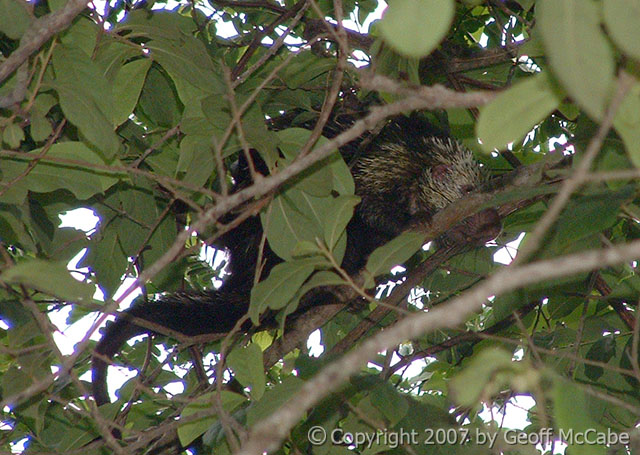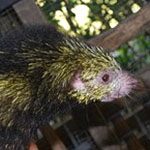- Home
- Accommodation
- Activities
- Area Info
- Maps
- Photo Galleries
- Real Estate
- Travel
Porcupine
Height: A porcupine can reach to a length from 25 – 36 in (60 – 90 cm); Tail, 8 – 10 in (20-25 cm) from head to body.
Weight: It is weighing 5 to 16 kilogram (12 – 35 lbs).
Life Span: 5-7 years in the wild.
Found In: The tree porcupine, also referred to as the Mexican hairy dwarf porcupine, is found exclusively in the Americas, mainly around Mexico, Honduras, Guatemala, Costa Rica and Panama. They can be found in several National Parks of Costa Rica.
 The porcupine belongs to the rodent family. It has black to brownish-yellow fur, and is extremely strong with short legs. Its hairless sole allow it to be an adept climber. It has a circular plump body, small ears and a partially developed head. The most distinguishable feature of the porcupine are its pointed quills. A single porcupine has about 30,000 odd quills. The quills are nothing but hair with pointed tips on the end. Quills are rough on the end and base and empty at the shaft. The porcupines possess these quills on all parts of their body, but not on the stomach.
The porcupine belongs to the rodent family. It has black to brownish-yellow fur, and is extremely strong with short legs. Its hairless sole allow it to be an adept climber. It has a circular plump body, small ears and a partially developed head. The most distinguishable feature of the porcupine are its pointed quills. A single porcupine has about 30,000 odd quills. The quills are nothing but hair with pointed tips on the end. Quills are rough on the end and base and empty at the shaft. The porcupines possess these quills on all parts of their body, but not on the stomach.
Porcupines are herbivores and normally survive on a diet of leaves, branches and green plants like clover and skunk cabbage. North American porcupines use their big front teeth to satisfy a healthy appetite for wood. In winter, they might eat bark. North American porcupines also eat leaves, fruit, and springtime buds. They can climb to the trees to find food. They are mostly nocturnal, but have sometime forage for food during the day.
 The porcupine uses its quills to defend itself in precarious situations. When a predator looms ahead, will turn, raise its prized quills and hit the enemy with full force with its tail. If the porcupine strikes an animal with its quills, the quills stay rooted in the animal. Due to the body temperature the barbs becomes enlarged and they turn out to be even more deeply entrenched in the skin. If a vital organ is targeted by the blow, it can be fatal for the animal. Though its attacks are fierce, porcupines are not by and large aggressive beings. They will attack only when confronted or when they sense potential danger by an enemy.
The porcupine uses its quills to defend itself in precarious situations. When a predator looms ahead, will turn, raise its prized quills and hit the enemy with full force with its tail. If the porcupine strikes an animal with its quills, the quills stay rooted in the animal. Due to the body temperature the barbs becomes enlarged and they turn out to be even more deeply entrenched in the skin. If a vital organ is targeted by the blow, it can be fatal for the animal. Though its attacks are fierce, porcupines are not by and large aggressive beings. They will attack only when confronted or when they sense potential danger by an enemy.
The tree porcupine is a nocturnal creature and will rarely be seen in the day. They generally live on the ground but some individuals prefer staying underground. Male porcupines are known to be aggressive with each other and are highly territorial in nature, though not with females. At night these pointy little creatures will go out to find food, mostly eating any fruits and other parts of a plant. The tree has a penchant for salty substances such as for chips or other inedible objects with a high salt content. Some communities with porcupines in the area create artificial salt licks a little further from settlements to keep the porcupines at bay.
The common porcupine is an excellent swimmer, as its hollow quills help keep it afloat. It is also a proficient tree-climber and spends much of its time on trees. It is a very vocal animal and is capable of making a wide range of sounds including moaning, coughing, whining, shrieking, wailing, and tooth clenching to communicate different emotions.
Porcupines normally mate during late summer and in the early fall. They run extremely vocal during the mating season. Males will get in a fiercely combative mode over females. The male porcupine carries out a very strange and complicated mating ritual dancing hysterically and spraying urine over his prospective mate. Their gestation period lasts for seven months. A single baby is born at a time. The trademark quills are often soft at birth and turn rough and pointy after an hour from birth. Though the infant is cared for by the other for about 6 months, it starts hunting for itself merely a few days after birth.
The common porcupine is found in most parts of Canada and western United States along with Southern Mexico. In the United States, it can be found in Wisconsin, Michigan, Pennsylvania, New York and New England. The Mexican hairy dwarf porcupine is a rodent spotted in Central America, mainly in Mexico, Honduras, Guatemala, Costa Rica and Panama. These mammals can be seen in several Costa Rican National Parks.
Further Reading
www.costaricajourneys.com/porcupine/
http://www.treeoflifecostarica.com/porcupine.php
http://qcostarica.com/2013/07/19/sloths-and-porcupines-under-attack-in-costa-rica/
http://www.conservenature.org/learn_about_wildlife/costa_rica_rainforest/prehensile_tailed_porcupine.htm
Great Stuff

Clandestina Restaurant
My new favorite restaurant, Clandestina is not to be missed by food lovers staying anywhere near to Montezuma. Established in March 2015, Clandestina is the new kid on the block. The Oregon/Tico collaboration is a winner among locals and travelers alike, with artisan craft beers, made onsite by Butterfly Brewing Co. and delicious, exciting […]











